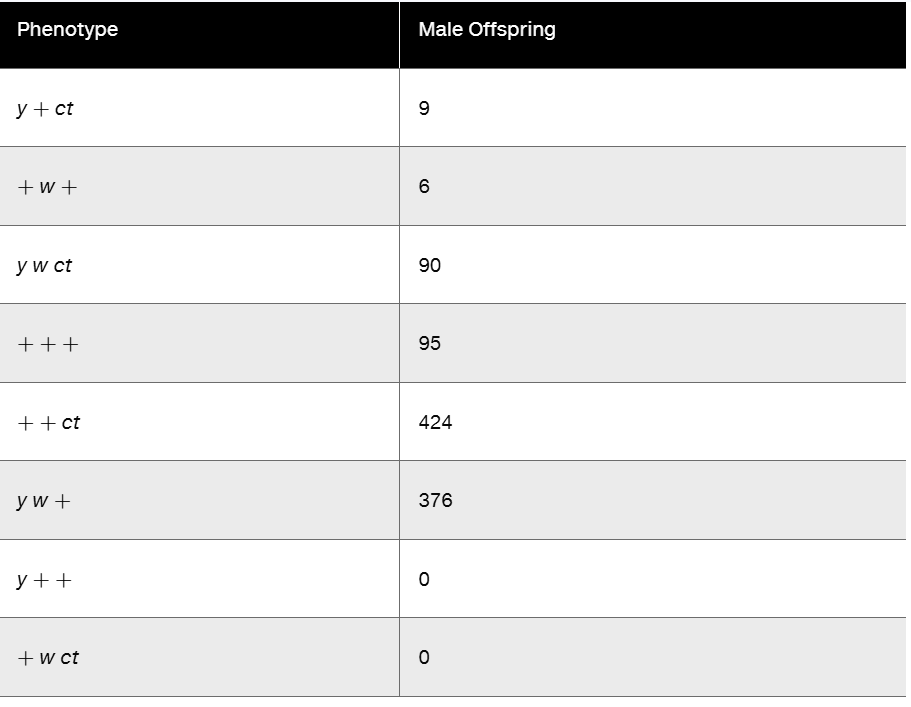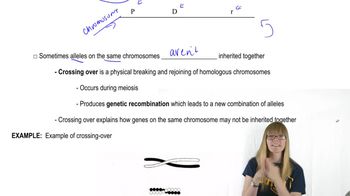A female with the following genotype can produce a number of different gametes. Choose the gamete produced if no crossovers have occurred. Genotype = a b + / + + c
Table of contents
- 1. Introduction to Genetics51m
- 2. Mendel's Laws of Inheritance3h 37m
- 3. Extensions to Mendelian Inheritance2h 41m
- 4. Genetic Mapping and Linkage2h 28m
- 5. Genetics of Bacteria and Viruses1h 21m
- 6. Chromosomal Variation1h 48m
- 7. DNA and Chromosome Structure56m
- 8. DNA Replication1h 10m
- 9. Mitosis and Meiosis1h 34m
- 10. Transcription1h 0m
- 11. Translation58m
- 12. Gene Regulation in Prokaryotes1h 19m
- 13. Gene Regulation in Eukaryotes44m
- 14. Genetic Control of Development44m
- 15. Genomes and Genomics1h 50m
- 16. Transposable Elements47m
- 17. Mutation, Repair, and Recombination1h 6m
- 18. Molecular Genetic Tools19m
- 19. Cancer Genetics29m
- 20. Quantitative Genetics1h 26m
- 21. Population Genetics50m
- 22. Evolutionary Genetics29m
4. Genetic Mapping and Linkage
Multiple Cross Overs and Interference
Problem 15c
Textbook Question
Another cross in Drosophila involved the recessive, X-linked genes yellow (y), white (w), and cut (ct). A yellow-bodied, white-eyed female with normal wings was crossed to a male whose eyes and body were normal but whose wings were cut. The F₁ females were wild type for all three traits, while the F₁ males expressed the yellow-body and white-eye traits. The cross was carried to an F₂ progeny, and only male offspring were tallied. On the basis of the data shown here, a genetic map was constructed.

Were any double-crossover offspring expected?
 Verified step by step guidance
Verified step by step guidance1
Step 1: Understand the genetic cross. The problem involves three X-linked genes in Drosophila: yellow (y), white (w), and cut (ct). These genes are recessive and located on the X chromosome. The parental cross involves a yellow-bodied, white-eyed female with normal wings (y w +) and a male with normal body and eyes but cut wings (+ + ct).
Step 2: Analyze the F₁ generation. The F₁ females are wild type for all traits (+ + +), indicating that the female inherited the dominant alleles from the male parent. The F₁ males express yellow body and white eyes (y w +), which indicates that they inherited the recessive alleles from the female parent.
Step 3: Examine the F₂ progeny. The F₂ generation includes male offspring with various phenotypes. The phenotypes and their frequencies are provided in the table. These frequencies will help determine the genetic map and identify crossover events.
Step 4: Identify parental, single-crossover, and double-crossover classes. The most frequent phenotypes represent the parental classes (+ + ct and y w +). The less frequent phenotypes represent single-crossover events, and the least frequent phenotypes (or zero-frequency phenotypes) represent double-crossover events. Double crossovers occur when two recombination events happen between the three genes.
Step 5: Determine if double-crossover offspring were expected. Double crossovers are expected based on the genetic distance between the genes. If the genes are far enough apart, double crossovers should occur. However, the absence of double-crossover phenotypes (y + + and + w ct) in the data suggests that the genetic distance between the genes may be small or that the sample size was insufficient to detect them.
 Verified video answer for a similar problem:
Verified video answer for a similar problem:This video solution was recommended by our tutors as helpful for the problem above
Video duration:
1mPlay a video:
Was this helpful?
Key Concepts
Here are the essential concepts you must grasp in order to answer the question correctly.
X-linked Inheritance
X-linked inheritance refers to the pattern of inheritance for genes located on the X chromosome. In Drosophila, males have one X chromosome and one Y chromosome, while females have two X chromosomes. This means that recessive traits linked to the X chromosome are more likely to be expressed in males, as they do not have a second X chromosome to mask the recessive allele.
Recommended video:
Guided course

X-Inactivation
Genetic Mapping
Genetic mapping is the process of determining the relative positions of genes on a chromosome based on the frequency of recombination between them. By analyzing offspring phenotypes from genetic crosses, researchers can estimate distances between genes, which helps in constructing a genetic map. The closer two genes are on a chromosome, the less likely they are to be separated by recombination during meiosis.
Recommended video:
Guided course

Mapping Overview
Double Crossover
A double crossover occurs when two separate crossover events happen between two linked genes during meiosis. This can lead to the exchange of genetic material between homologous chromosomes, potentially resulting in offspring with recombinant phenotypes. The frequency of double crossovers can be calculated using the recombination frequencies of the genes involved, and their occurrence can affect the expected ratios of phenotypes in the offspring.
Recommended video:
Guided course

Double Strand Breaks

 6:14m
6:14mWatch next
Master Multiple Cross Overs and Interference with a bite sized video explanation from Kylia
Start learningRelated Videos
Related Practice
Multiple Choice
762
views
2
rank
